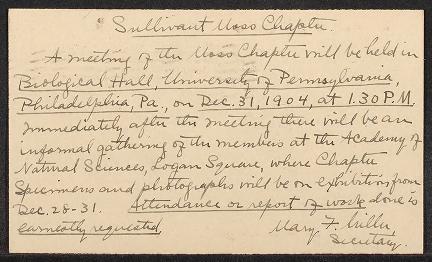This summer, I researched the history of women in science at the Smithsonian and helped to develop a dataset about women in science called the Funk List . During my research as an intern with the American Women's History Initiative and the Smithsonian Institution Archives, one woman stood out to me. Mary Farnham Miller (1872-1920) was a temporary staff member with the Smithsonian’s Department of Botany beginning in 1917. Although Miller did not have many publications linked to her name, I was able to trace her career through Smithsonian Institution Archives records.

I first came across Miller’s name when I was exploring the Funk List. Miller was someone who had yet to be researched, so I devoted time to find more about her life. I began by searching the Smithsonian’s digitized collections. I found references to her membership in the Sullivant Moss Society, now known as the American Bryological and Lichenological Society. Then, I searched for the society’s annual reports through the Biodiversity Heritage Library and found a memorial in its 1920 publication. This provided information like birth and death dates and mentioned her career at the Smithsonian. This initial research offered a solid base for further study.
The newly uncovered sources provided more keywords to use in future research. With this snowball effect, a clearer picture of Miller’s life emerged. In the June 9, 1882, issue of the Evening Critic newspaper, we find that she was born in 1872 in Washington, D.C, and, during her formative years, she attended Miss Osborne’s Seminary. From 1902-1920, Miller was an active member of the Sullivant Moss Society, an organization founded to study the biology of bryophytes and lichen-forming fungi. By 1908, she had been the chapter secretary and the chapter curator of the Society’s Lichen Department. Miller was later hired as a temporary assistant botanist for the Smithsonian in 1917. As an assistant, she researched lichens and mosses while caring for some of the collections at the U.S. Herbarium. While it’s unclear when she stopped working with the Smithsonian, she died in Washington, D.C in 1920.

Throughout her career, Miller was also an avid collector and specialized in lichens. She traveled extensively along the Northeastern coast and collected specimens from Maine, New Hampshire, Vermont, Massachusetts, New York, Pennsylvania, Maryland, and Virginia as evidenced in Harvard University Herbaria & Libraries and the Smithsonian’s Department of Botany Collections. She corresponded quite frequently with botanists James Franklin Collins and George Edward Davenport as well as naturalist Bernt Olaf Wolden.

Throughout this project, I was able to recover many aspects of Mary Farnham Miller’s life and career. I also learned to creatively navigate research with limited starting information. Using my newfound knowledge, I contributed more information to the Funk List and shed new light on Miller’s life to hopefully help inspire further research.
Related Resources
- "Smithsonian Women in Science," by Elizabeth Harmon, The Bigger Picture, Smithsonian Institution Archives.
- “Because of Her Story: The Funk List,” Because of Her Story, Smithsonian American Women's History Initiative.
- “Women of the United States National Herbarium,” Department of Botany
- “Miss Osborn’s Seminary,” The Evening Critic, June 9, 1882, page 3.
Produced by the Smithsonian Institution Archives. For copyright questions, please see the Terms of Use.

Leave a Comment